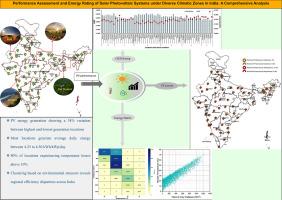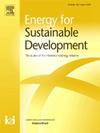太阳能光伏系统在不同气候条件下的潜力和性能评估:综合分析
IF 4.9
2区 工程技术
Q2 ENERGY & FUELS
引用次数: 0
摘要
在全球可再生能源市场上,光伏发电系统的安装正在迅速扩大。然而,不同的气候和地理条件对这些系统的性能有重大影响,需要进行严格的分析。因此,这项工作的重点是调查PV在不同地形变化下的性能,从热带到温带气候遍及印度。该分析基于关键性能参数,包括发电量、比发电量、容量系数、光伏损耗,以及根据IEC 61853标准计算的运行条件频率分布、发电量和气候特定能量等级(CSER)。此外,还进行了基于主要环境压力源的映射和聚类。研究结果对印度不同地区的光伏系统在真实室外条件下的效率有了更全面的了解。光伏发电量从1250到1891千瓦时/千瓦时/年不等,最高和最低发电量之间的差异为34%。大多数地区的平均日发电量在4.25至4.50千瓦时/千瓦时/天之间。温度损失从5.30%到14.10%不等,超过80%的地点温度损失超过10%。发电量分析显示,最频繁的运行条件并不总是与发电量最高的运行条件相同。基于环境压力源的聚类揭示了区域效率差异,印度东北部效率最高,北部和西部效率最低。这项研究为研究人员、太阳能开发商、消费者、投资者和政策制定者提供了有价值的见解,促进了与可持续发展目标7和可持续发展目标13相一致的区域太阳能战略。本文章由计算机程序翻译,如有差异,请以英文原文为准。

Potential and performance assessment of solar photovoltaic systems across diverse climatic conditions: A comprehensive analysis
The installation of photovoltaic systems for power generation is rapidly expanding worldwide in the renewable energy market. However, the varying climate and geographical conditions have a significant impact on the performance of these systems which requires to be critically analyzed. Therefore, this work focuses on the investigation of PV performance under diverse topographical variations ranging from tropical to temperate climates across India. The analysis is based on the key performance parameters, including energy generation, specific energy yield, capacity factor, PV losses along with the calculation of frequency distribution of operating conditions, energy generation, and Climate-Specific Energy Rating (CSER) as per IEC 61853 standards. Additionally, mapping and clustering based on major environmental stressors are also done. The results present a more comprehensive understanding of PV system efficiency under real outdoor conditions for various locations in India. The PV energy generation is found to vary from 1250 to 1891 kWh/kWp/year, showing a 34 % variation between the highest and lowest generation locations. Most locations generate average daily energy between 4.25 and 4.50 kWh/kWp/day. The temperature losses vary from 5.30 % to 14.10 %, with over 80 % of locations experiencing temperature losses above 10 %. The energy generation analysis revealed that the most frequent operating conditions are not always the same as those where highest generation occurs. Clustering based on environmental stressors reveals regional efficiency disparities, with the highest in the northeast and the lowest in the northern and western parts of India. This research provides valuable insights for researchers, solar developers, consumers, investors, and policymakers, promoting region-specific solar energy strategies aligned with SDG 7 and SDG 13.
求助全文
通过发布文献求助,成功后即可免费获取论文全文。
去求助
来源期刊

Energy for Sustainable Development
ENERGY & FUELS-ENERGY & FUELS
CiteScore
8.10
自引率
9.10%
发文量
187
审稿时长
6-12 weeks
期刊介绍:
Published on behalf of the International Energy Initiative, Energy for Sustainable Development is the journal for decision makers, managers, consultants, policy makers, planners and researchers in both government and non-government organizations. It publishes original research and reviews about energy in developing countries, sustainable development, energy resources, technologies, policies and interactions.
 求助内容:
求助内容: 应助结果提醒方式:
应助结果提醒方式:


